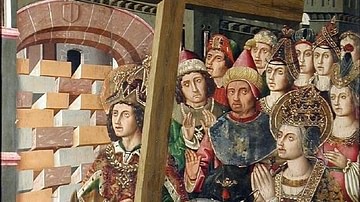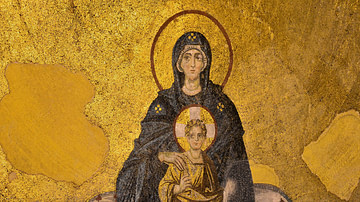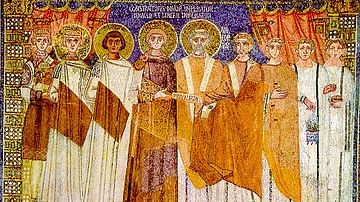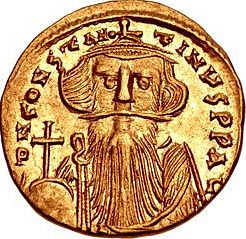
Constans II (aka Konstans II) was emperor of the Byzantine Empire from 641 to 668 CE. Sometimes known as Constans Pogonatos (“the Bearded”), he came to the throne by a series of unlikely events and his empire was immediately challenged almost everywhere by the rising Arab Caliphate. He attempted to end the Church's divisive debate on Christ's nature and will but succeeded in only antagonising the Popes and ensuring his name would be denigrated by Christian historians thereafter. Like so many of his predecessors, he faced endless revolts and usurpers and met his death at the hands of an assassin while taking a bath.
Succession
Heraclius had ruled as emperor since 610 CE, and his reign was a mixed one. He had rescued the empire from disaster when Constantinople was besieged in 626 CE but had lost Jerusalem to the Persians. Victory at Nineveh put the empire back on its feet, but the new threat was the Arab Caliphate which showed its intent by crushing a Byzantine army at Yarmuk in 636 CE. Rumours spread that the Byzantines were suffering the wrath of God, angry at the emperor's incestuous marriage to his own niece Martina.
When Heraclius died in 641 CE, he had two heirs who ruled as co-emperors: Heraklonas (whose mother was Martina) and Constantine III (whose mother was Heraclius' first wife Eudokia). When Constantine died in mysterious circumstances a few months later, Martina was able to act as regent for her son Heraklonas, even declaring herself co-emperor. Defeats to the Arabs continued as before, and the imminent loss of Alexandria allowed one Valentinos Arsakuni, a military governor of the Opsikion province, to capitalise on Martina's unpopularity and take power for himself in September 641 CE. A few months later, Valentinos was removed and killed by a lynch mob who favoured a properly royal ruler, the son of Constantine III, Flavius Heraclius, better known by his nickname Constans. The legitimate line had been restored, but the new emperor was a mere 11 years of age and the empire was in disarray.
Military Campaigns
Constans II had little time to warm the seat of his throne before he, and the Senate acting as his regent, had to deal with the ever-expanding Arab Caliphate. Alexandria fell in 642 CE, and losses followed in Armenia in the same year. The former was the more serious as it was the richest province in the empire and the most important source of grain. In 647 CE the Arabs overran Carthage in North Africa and parts of Asia Minor, notably capturing Caesarea. In 649 CE Cyprus was attacked, one of the empire's major naval bases, and though the island remained a shared property thereafter, the Arabs managed to sack the capital Constantia and destroy the harbour installations.
Next, Crete, Kos, and Rhodes all fell to Arab raids in 654 CE. The Byzantine Empire was crumbling at the edges, there were revolts in North Africa and Italy, and Constans could have been forgiven for thinking it could not possibly get any worse. In 655 CE it did. Sailing with a Byzantine fleet, the emperor was horrified to see an Arab armada bearing down on him off the coast of Phoenix (modern Finike) in Lycia. Only by switching clothes with an ordinary seaman did Constans escape while the entire fleet (and the unfortunate seaman) were sent to the bottom of the Mediterranean.
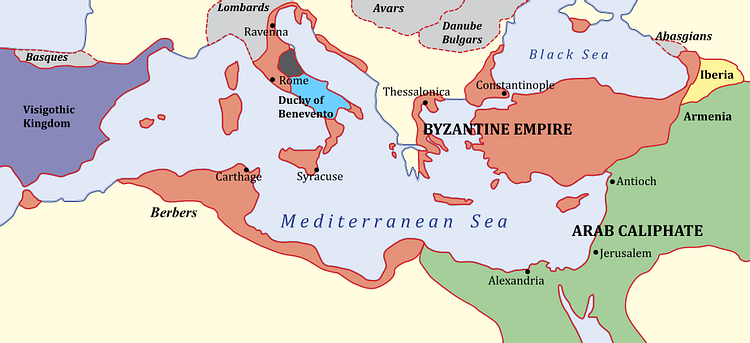
Then, from 656 CE, relief came from an unlikely source. The Arabs imploded in a bloody civil war which would last until 661 CE and divert their attention from further foreign conquests. In 659 CE a peace was signed between the two powers with the Byzantines having to pay a massive tribute. While the Caliphate was busy deciding who should be the next caliph, Constans did not waste any time and invaded northern Greece. The captured Slavs from that campaign were forcibly relocated to Asia Minor and then conscripted into the Byzantine army. Perhaps predictably, at the first opportunity, 5,000 of the Slav soldiers defected to the Arabs in 665 CE. Meanwhile, Constans' campaigns against the Lombards in Italy in 663 CE did not make much headway, although Sardinia had been held in 645 CE.
Religious Intervention
In 648 CE Constans passed an imperial edict, the Typos, which was designed to pacify the opponents of Monotheletism (that Christ had a single will) in the Church and close the endless and harmful debate that had been raging for half a century. Rather ambitiously, the edict simply forbade any discussion on the issue: bishops would be dismissed and laymen flogged and exiled if they did. In the long-running saga which split the eastern and western branches of the Church over ecclesiastical doctrine, the edict was condemned by Pope Martin I in 649 CE.
The Popes were keen to maintain their own ascendancy over Constantinople in deciding matters of dogma and Martin excommunicated the bishop of Constantinople. Constans responded by having the Constantinople Senate declare the Pope guilty of treason and exiling Martin to Cherson in the Crimea in 654 CE on the excuse that he had supported Olympios, the rebel governor of Byzantine Ravenna. Maximos the Confessor, a vocal supporter of Martin and opponent of Monotheletism, was also exiled, in his case to Lazika on the eastern shores of the Black Sea. Constans was, nevertheless, received by the new Pope Vitalian in Rome on a visit in 663 CE. The emperor attempted some sort of reconciliation and came bearing gifts which included a gold pallium or cloth; then he promptly stripped the city of as much bronze he could find, spiriting away statues and even the bronze roof tiles of churches and the copper roofing of the Pantheon.
Death & Successor
In 663 CE Constans took up permanent residence in Syracuse on Sicily. The emperor considered moving his capital to his new home for greater safety, but this met obvious disapproval from the aristocracy at Constantinople with the Senate even forbidding any imperial family members from joining the emperor in Sicily. The debate ended when Constans was killed in his bath by one of his own military entourage on 15 September 668 CE, with the inglorious weapon, a soap dish. Not particularly popular (either at home or in Syracuse), subject to several rebellions, despised by half the Church and with too many failures on the battlefield, he would not be missed by many, but he had, at the very least, ensured there was still an empire to pass on to his successors. Constans was succeeded by his son, Constantine IV, who had already been crowned co-emperor in 654 CE and who would rule until 685 CE.
